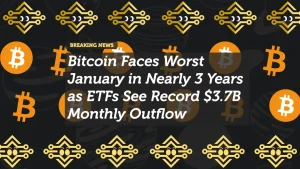
Bitcoin Warning Light Flashes Red As Gold Hits Record High, Signaling Potential Market Volatility
The Bitcoin price warning light has just turned red once again as gold — the age-old store of value — surged to a new all-time high this week. The sharp move in the precious metal’s price comes amid renewed global uncertainty, pushing investors toward safer havens and signaling potential turbulence across the broader crypto market.
According to data from Bloomberg, spot gold climbed above $2,540 per ounce on Monday, surpassing its previous peak set earlier this year. The move reflects growing fears around inflation, global debt expansion, and monetary instability — conditions that have often spurred volatility in Bitcoin (BTC) and other digital assets.
Gold’s Breakout: A Signal Of Macro Stress
Historically, gold’s rally tends to coincide with risk aversion and market stress. Analysts now argue that the metal’s breakout could serve as an indirect warning for Bitcoin and crypto investors, as both assets often compete for investor attention during macroeconomic shocks.
“Whenever gold surges while risk assets stagnate, it often signals tightening liquidity,” said crypto strategist Ian Myers from ChainMetrics. “This environment may trigger a short-term correction in Bitcoin price even if the long-term thesis remains intact.”
The Bitcoin price has hovered around $118,400 over the last 24 hours, down 1.2% on the day, while Ethereum slipped below $4,450. Altcoins, including Solana and XRP, also recorded mild declines as traders reassessed risk exposure heading into next week’s Federal Reserve minutes release.
Bitcoin’s Correlation Shift: From Gold Ally To Risk Asset
While Bitcoin has often been dubbed “digital gold,” recent data shows that the correlation between the two has weakened. Over the past six months, Bitcoin’s price has mirrored equities more closely than gold, aligning with broader risk-on sentiment.
However, the latest surge in gold could mark a macro inflection point, prompting a recalibration in investor behavior. If global liquidity contracts and bond yields rise, Bitcoin’s correlation with gold may strengthen again, especially if institutions seek inflation hedges through crypto ETFs.
ETF Flows Signal Caution
Despite strong long-term demand, spot Bitcoin ETFs have seen net outflows of $540 million this week, the largest since mid-August. Analysts attribute this to profit-taking near record highs and uncertainty about Fed policy direction.
Meanwhile, BlackRock’s iShares Bitcoin Trust (IBIT) remains the largest holder of institutional BTC, now managing over 815,000 coins after $4 billion in recent inflows. However, the pace of inflows has slowed considerably, suggesting that some institutions are taking a defensive stance.
According to CoinShares’ latest report, institutional flows into gold ETFs jumped 9% in the same period — the largest weekly increase since 2021. The rotation of capital from crypto to gold could pressure Bitcoin’s near-term price structure.
Bitcoin Technical Indicators Flash Red
On the charts, Bitcoin is flashing multiple bearish divergence signals. The Relative Strength Index (RSI) has been trending downward since late September despite higher price highs — a classic sign of weakening momentum.
Key support sits at $115,000, followed by a psychological floor at $110,000. A breakdown below these levels could invite deeper corrections toward the $105,000–$108,000 range.
Still, some analysts maintain that the correction would be healthy given Bitcoin’s 60% year-to-date rally. “A consolidation phase here would reset leverage and prepare the market for a Q4 push,” explained crypto trader Michaël van de Poppe on X (formerly Twitter).
Gold’s Strength May Benefit Bitcoin Long Term
While short-term caution dominates, the long-term narrative remains constructive. Both gold and Bitcoin thrive on distrust in fiat systems, and as central banks continue to expand balance sheets, the case for decentralized assets only grows stronger.
As history shows, gold’s all-time highs often precede major crypto rallies, particularly when inflation expectations stay elevated. If this trend repeats, Bitcoin may consolidate before attempting another move toward $125,000–$130,000 later this quarter.
What’s Next For Crypto Markets?
The next key catalysts for Bitcoin and broader crypto markets include:
- The Federal Reserve’s October policy update,
- Potential rate cuts hinted by Jerome Powell,
- Continued ETF inflow data, and
- Gold’s ability to sustain above its breakout level.
If global risk appetite returns and macro pressure eases, Bitcoin could rebound sharply. Otherwise, expect a volatile October as traders weigh gold’s dominance against crypto’s long-term promise.
Conclusion
The surge in gold prices may seem unrelated, but for seasoned investors, it’s a classic warning signal of tightening liquidity and rising uncertainty — both of which can ripple through Bitcoin and the broader crypto market.
While the Bitcoin price warning light has flashed red, it doesn’t spell disaster — rather, it suggests a period of consolidation before the next leg higher. If history is any guide, this interplay between gold and Bitcoin could once again set the stage for crypto’s next major rally.
















